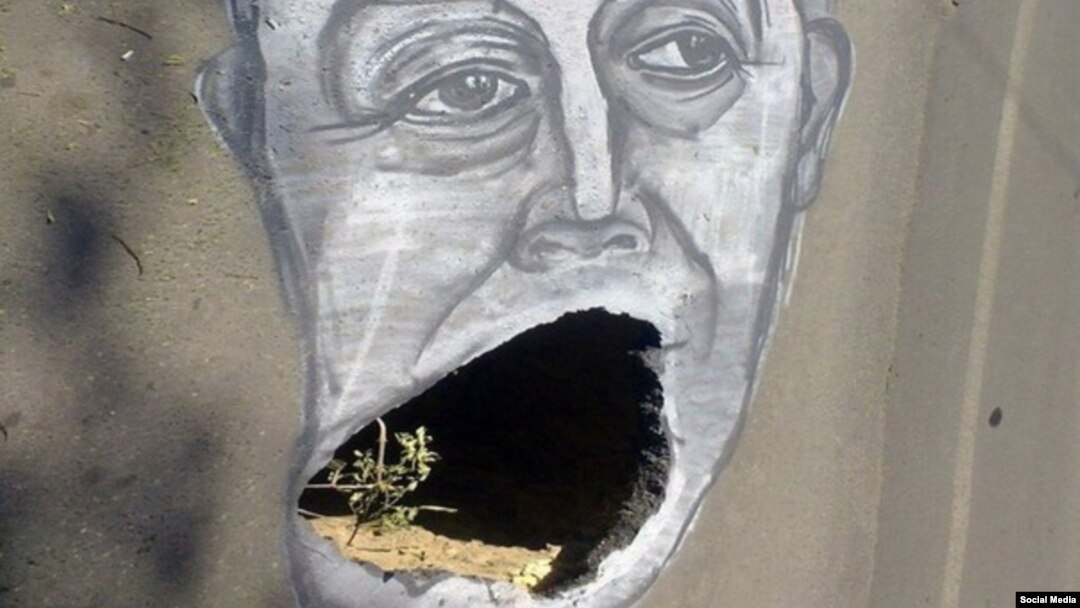Crumbling roads have long provoked grassroots outrage in Russia, where no less than President Vladimir Putin has attributed the abysmal condition of the country's thoroughfares to pervasive corruption in the road-construction industry.
Russian activists in recent years have taken their disgust with this state of affairs to the streets, both literally and creatively, by painting caricatures of local and regional officials over potholes that serve as comically grotesque mouths in the portraits.
One such image resembling Saratov Governor Valery Radayev has gripped the local political and media establishment, sparking fervent talk of a political "hit job" that comes at the midway point of a regional street-repair initiative dubbed Year Of The Road.
The pothole-adorned portrait was discovered the morning of June 11 on a central street in Saratov, 350 kilometers southwest of Moscow.
A week earlier, a large municipal KamAZ truck was immobilized after its front wheel plunged into that very pothole, right in front of the regional branch of the All-Russian National Front, a movement formed by Putin in 2011.
A message stenciled next to the caricature on the street read: "Radayev, thank you for Year Of The Roads.
Local authorities quickly dispatched a street sweeper to the scene, though it was unable to scrub away Radayev's likeness. Workers then proceeded to paint over the picture, and later filled in the pothole.
Days later, Saratov police hauled in the man who painted the caricature, a 20-year-old graffiti artist named Vikenty Belikov. He told RFE/RL that he was apolitical and that a local activist with the ultranationalist Liberal Democratic Party paid him 10,000 rubles ($186) for the job.
"I would never go and draw a face resembling the governor's over a pothole on my own initiative," Belikov said in a telephone interview. "It's just not interesting for me."
He added that police said they could fine him up to 500 rubles ($9) for an administrative violation but ultimately decided not to. Police were more interested in finding out who paid him for the street portrait, Belikov said.
The head of the Saratov region's public council, a consultative body to the regional administration, called the pothole portrait a "political hit job" aimed at smearing the governor.
"While regional authorities are doing all they can to secure resources for roads amid the difficult conditions presented by a budget deficit, others are trying to score political points with petty, dirty tricks," the official, Aleksandr Lando, told the news portal SarInform.
The strategy of shaming Russian officials over road conditions by painting their pictures over potholes appears to have first emerged a few years ago, most notably in the Urals city of Yekaterinburg.
Last month, pothole caricatures of the city manager of Ryazan, 200 kilometers southeast of Moscow, were posted on a Twitter fan account dedicated to renowned guerrilla artist Banksy that has 1.3 million followers.
Ryazan police subsequently investigated street images of the local administration head, Oleg Bulenkov.
The Ryazan incident prompted Russian State Duma Deputy Sergei Mironov, a Putin loyalist who heads a party that positions itself as an opposition movement, to criticize local authorities for choosing to paint over the images of Bulenkov before fixing the potholes.
Russian authorities have largely moved to restrict or co-opt grassroots dissatisfaction with the government during Putin's 15 years in power.
But it has often moved delicately when dealing with discontent among the country's drivers, who have proven themselves capable of mobilizing protesters on issues ranging from import tariffs and road privileges flaunted by Russia's ruling elite.
Belikov, the Saratov graffiti artist, chose his words carefully when describing the subject of his pothole portrait, saying only that he based it on a picture of someone who "resembled" Radayev, the Saratov governor and a member of Putin's United Russia party.
As for Radayev, his spokeswoman told the local news site Vzglyad-Info that while the governor had a sense of humor, he didn't recognize himself in Belikov's portrait.
"‘It doesn't look like me,'" she quoted the governor as saying.



